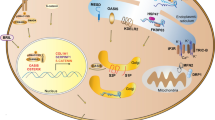Abstract
Helical mutations near the amino (N)-proteinase cleavage site have been suggested to result in a mixed osteogenesis imperfecta (OI)/Ehlers-Danlos syndrome (EDS) phenotype (Malfait et al. 2013).
Access provided by CONRICYT-eBooks. Download reference work entry PDF
Similar content being viewed by others
Helical mutations near the amino (N)-proteinase cleavage site have been suggested to result in a mixed osteogenesis imperfecta (OI)/Ehlers-Danlos syndrome (EDS) phenotype (Malfait et al. 2013).
Synonyms and Related Disorders
Ehlers-Danlos syndrome; Mixed OI/EDS phenotype; Osteogenesis imperfecta
Genetics/Basic Defects
-
1.
Most of the patients studied harbored a COL1A1/COL1A2 mutation residing within the most N-terminal part of the type I collagen helix (Nicholls et al. 1992; Feshchenko et al. 1998; Raff et al. 2000; Cabral et al. 2005) (Malfait et al. 2013).
-
2.
These mutations affect the rate of type I collagen N-propeptide cleavage and disturb normal collagen fibrillogenesis.
Clinical Features
-
1.
Mainly present as EDS signs (Malfait et al. 2013)
-
1.
Severe joint hyperlaxity
-
2.
Soft and hyperextensible/translucent skin
-
3.
Abnormal wound healing
-
4.
Easy bruising
-
5.
Mild abnormal scarring
-
6.
Sometimes signs of arterial fragility
-
1.
-
2.
Show only subtle signs of OI
-
1.
Blue sclera
-
2.
Osteopenia
-
3.
Fractures
-
4.
Relatively short stature
-
1.
-
3.
Hypotonia
-
4.
Clinical overlap with other EDS subtypes, including the classic, hypermobility, vascular, arthrochalasis, and kyphoscoliosis types
Diagnostic Investigations
-
1.
Biochemical collagen analysis: a powerful tool necessary to establish the diagnosis because of clinical overlapping with other EDS subtypes
-
2.
Molecular sequencing of COL1A1 and COL1A2: allows identification of heterozygous mutations in the triple helical region close to the procollagen type I N-proteinase cleavage site (Malfait et al. 2013)
Genetic Counseling
-
1.
Recurrence risk
-
1.
Patient’s sib: if a parent of the proband is affected, the risk to each sib is 50%.
-
2.
Patient’s offspring: a 50% chance of inheriting the mutation and developing the disorder.
-
1.
-
2.
Prenatal diagnosis: has not been accomplished.
-
3.
Management: please see the chapters of osteogenesis and Ehlers-Danlos syndrome.
(a–c) This 3-year-old Caucasian boy was evaluated for collarbone fractures, blue sclera, hypotonia, and hypermobile joints and to rule out osteogenesis imperfecta. He was noted to have hyperextensible fingers/wrists, knees, and ankles and bruise throughout the body. COL1A2 sequencing identified c.432 + 4_432 + 5insAA in one allele of COL1A2, the gene that encodes the pro-alpha 2 (I) chain of type I procollagen. The reference laboratory was able to characterize the outcome of splicing to have resulted in skipping of exon 9 and a mixed osteogenesis imperfecta and Ehlers-Danlos syndrome phenotype with fractures and joint hypermobility.
References
Cabral, W. A., Makareeva, E., Colige, A., et al. (2005). Mutations near amino end of α1(I) collagen cause combined osteogenesis imperfecta/Ehlers-Danlos Syndrome by interference with N-propeptide processing. Journal of Biological Chemistry, 280, 19259–19269.
Feshchenko, S., Brinckmann, J., Lehmann, H. W., et al. (1998). Identification of a new heterozygous point mutation in the COL1A2 gene leading to skipping of exon 9 in a patient with joint laxity, hyperextensibility of skin and blue sclerae. Human Mutation, 12, 138.
Malfait, F., Symoens, S., Goeman, N., et al. (2013). Helical mutations in type I collagen that affect the processing of the amino-propeptide result in an osteogenesis imperfecta/Ehlers-Danlos syndrome overlap syndrome. Orphanet Journal of Rare Diseases, 8, 78–98.
Nicholls, A. C., Oliver, J., Renouf, D. V., et al. (1992). The molecular defect in a family with mild atypical osteogenesis imperfecta and extreme joint hypermobility: exon skipping caused by an 11-bp deletion from an intron in one COL1A2 allele. Human Genetics, 88, 627–633.
Raff, M. L., Craigen, W. J., Smith, L. T., et al. (2000). Partial COL1A2 gene duplication produces features of osteogenesis imperfecta and Ehlers-Danlos syndrome type VII. Human Genetics, 106, 19–28.
Author information
Authors and Affiliations
Rights and permissions
Copyright information
© 2017 Springer Science+Business Media LLC
About this entry
Cite this entry
Chen, H. (2017). Osteogenesis Imperfecta/Ehlers-Danlos Syndrome Overlap Syndrome. In: Atlas of Genetic Diagnosis and Counseling. Springer, New York, NY. https://doi.org/10.1007/978-1-4939-2401-1_265
Download citation
DOI: https://doi.org/10.1007/978-1-4939-2401-1_265
Published:
Publisher Name: Springer, New York, NY
Print ISBN: 978-1-4939-2400-4
Online ISBN: 978-1-4939-2401-1
eBook Packages: MedicineReference Module Medicine





